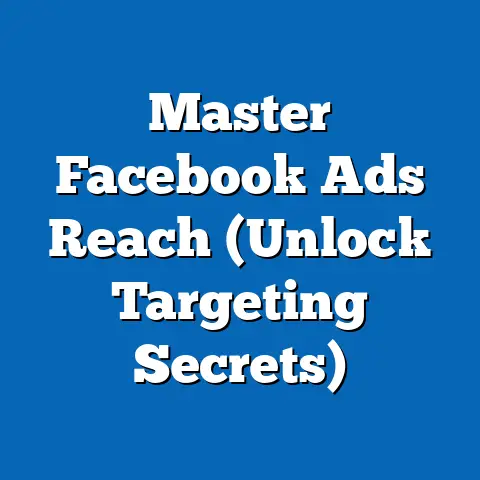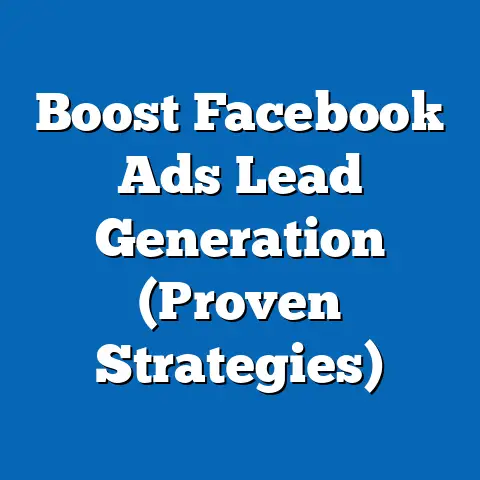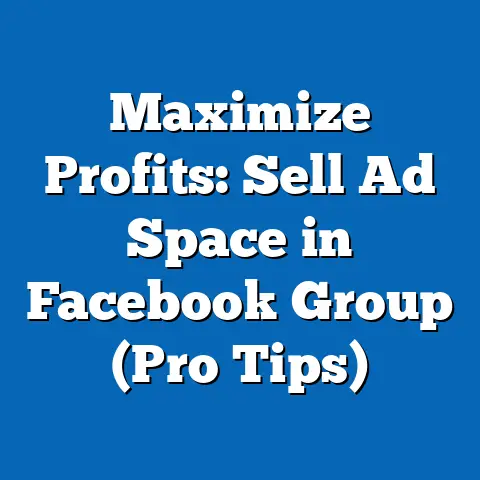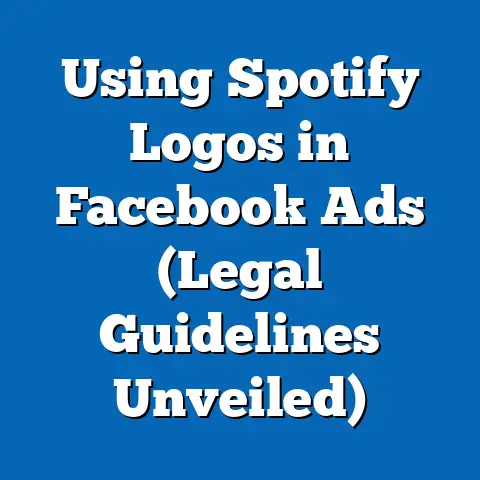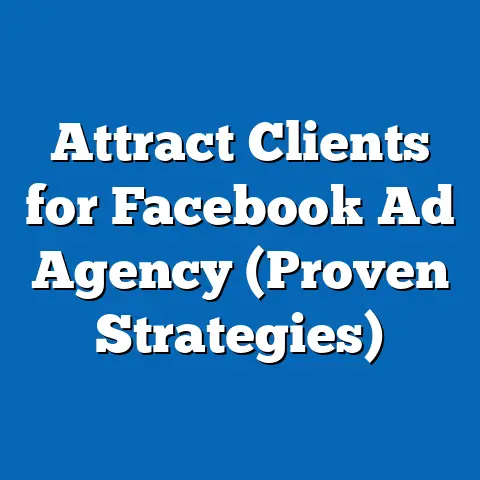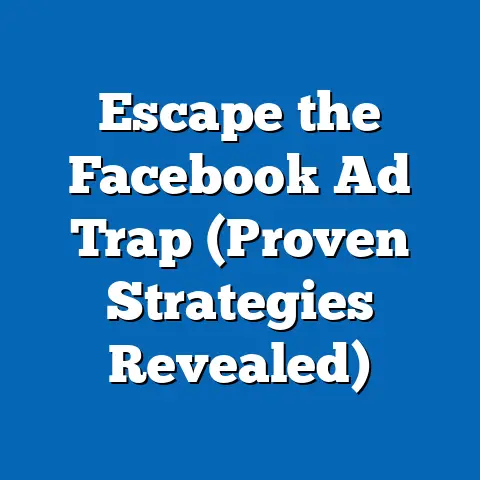Switching Facebook Ad Objective (Expert Guide Inside)
Remember the days when sending a letter meant finding a stamp, writing with your best penmanship, and hoping that the postman wouldn’t misplace it? Fast forward to today, where ad campaigns can be switched faster than you can change your outfit for a night out. Welcome to the world of Facebook advertising, where your ad objectives can be as dynamic as your weekend plans! I’ve seen firsthand how adapting your campaign objectives can be a game-changer, turning stagnant results into soaring success. Let’s dive into the art and science of switching Facebook ad objectives, ensuring you’re always one step ahead in this fast-paced digital world.
Understanding Facebook Ad Objectives
Facebook ad objectives are the foundation of any successful campaign. They tell Facebook what you want to achieve with your ads, and the platform uses this information to optimize delivery and target the right audience. Think of it like setting a destination in your car’s GPS; without a clear destination, you’re just driving around aimlessly, wasting gas and time.
What are Facebook Ad Objectives?
Simply put, Facebook ad objectives are the goals you set for your ad campaigns. They guide Facebook’s algorithm in showing your ads to people who are most likely to take the desired action, whether it’s visiting your website, watching a video, or making a purchase. Choosing the right objective is crucial because it directly impacts how Facebook optimizes your ad delivery and, ultimately, your return on investment (ROI).
Categories of Ad Objectives
Facebook categorizes its ad objectives into three main groups: Awareness, Consideration, and Conversion. Each category contains specific objectives tailored to different marketing goals. Let’s break them down:
-
Awareness: These objectives are designed to increase brand visibility and reach a broad audience.
- Brand Awareness: Shows your ads to people who are most likely to remember them. It’s all about getting your brand name out there.
- Reach: Maximizes the number of people who see your ads. Ideal for campaigns focused on broad exposure.
Example: I once ran a campaign for a local coffee shop using the Brand Awareness objective. The goal wasn’t immediate sales, but rather to make sure everyone in the neighborhood knew about the new spot. We saw a significant increase in foot traffic over the following weeks, proving the power of simply being top-of-mind.
-
Consideration: These objectives aim to engage your audience and encourage them to learn more about your business.
- Traffic: Sends people to your website, app, or Facebook page.
- Engagement: Increases likes, shares, comments, and event responses.
- App Installs: Encourages people to download your mobile app.
- Video Views: Maximizes the number of people who watch your video content.
- Lead Generation: Collects contact information from people interested in your products or services.
- Messages: Starts conversations with potential customers on Messenger, WhatsApp, or Instagram Direct.
Example: For a client launching a new online course, I used the Traffic objective to drive visitors to their landing page. We saw a significant increase in website traffic and, more importantly, a higher conversion rate of visitors signing up for the course.
-
Conversion: These objectives are focused on driving specific actions that directly contribute to your business goals, such as sales or leads.
- Conversions: Encourages people to take valuable actions on your website or app, such as making a purchase, filling out a form, or subscribing to a newsletter.
- Catalog Sales: Promotes products from your e-commerce catalog to people who are most likely to buy them.
- Store Traffic: Drives foot traffic to your physical store locations.
Example: I worked with an e-commerce client who wanted to increase online sales. By using the Conversions objective and optimizing for purchases, we saw a significant boost in their online revenue within a few weeks.
Awareness: These objectives are designed to increase brand visibility and reach a broad audience.
- Brand Awareness: Shows your ads to people who are most likely to remember them. It’s all about getting your brand name out there.
- Reach: Maximizes the number of people who see your ads. Ideal for campaigns focused on broad exposure.
Example: I once ran a campaign for a local coffee shop using the Brand Awareness objective. The goal wasn’t immediate sales, but rather to make sure everyone in the neighborhood knew about the new spot. We saw a significant increase in foot traffic over the following weeks, proving the power of simply being top-of-mind.
Consideration: These objectives aim to engage your audience and encourage them to learn more about your business.
- Traffic: Sends people to your website, app, or Facebook page.
- Engagement: Increases likes, shares, comments, and event responses.
- App Installs: Encourages people to download your mobile app.
- Video Views: Maximizes the number of people who watch your video content.
- Lead Generation: Collects contact information from people interested in your products or services.
- Messages: Starts conversations with potential customers on Messenger, WhatsApp, or Instagram Direct.
Example: For a client launching a new online course, I used the Traffic objective to drive visitors to their landing page. We saw a significant increase in website traffic and, more importantly, a higher conversion rate of visitors signing up for the course.
Conversion: These objectives are focused on driving specific actions that directly contribute to your business goals, such as sales or leads.
- Conversions: Encourages people to take valuable actions on your website or app, such as making a purchase, filling out a form, or subscribing to a newsletter.
- Catalog Sales: Promotes products from your e-commerce catalog to people who are most likely to buy them.
- Store Traffic: Drives foot traffic to your physical store locations.
Example: I worked with an e-commerce client who wanted to increase online sales. By using the Conversions objective and optimizing for purchases, we saw a significant boost in their online revenue within a few weeks.
Impact on Campaign Performance and ROI
Choosing the right ad objective is not just a formality; it’s a strategic decision that can significantly impact your campaign’s performance and ROI. When you select an objective that aligns with your business goals, Facebook’s algorithm works to find people who are most likely to take the desired action. This leads to more efficient ad spending and better results.
- Improved Targeting: Facebook uses its vast data to identify users who are most likely to respond to your ads based on the chosen objective.
- Efficient Ad Delivery: The algorithm optimizes ad delivery to ensure your ads are shown to the right people at the right time.
- Higher ROI: By focusing on the right objective, you can maximize the value of your ad spend and achieve a higher return on investment.
Key Takeaway: Understanding and selecting the right Facebook ad objective is the cornerstone of a successful campaign. Take the time to align your objectives with your business goals for optimal results.
When and Why to Switch Your Ad Objective
Sometimes, what starts as a brilliant plan can hit a snag. That’s where the flexibility of switching ad objectives comes in. I’ve learned that being able to adapt your strategy based on changing circumstances is a crucial skill for any Facebook advertiser.
Scenarios Where Switching is Necessary
There are several scenarios where switching ad objectives may be necessary. Here are a few common examples:
-
Changes in Business Goals: Your business goals may evolve over time. For example, you might start with a focus on brand awareness and then shift to driving sales. In this case, you would need to switch from an Awareness objective to a Conversion objective.
Example: A startup I consulted with initially focused on building brand awareness. Once they gained traction, they shifted their focus to driving sales. We switched their ad objective from Brand Awareness to Conversions, and their sales skyrocketed.
-
Shifts in Target Audience Behavior: Your target audience’s behavior and preferences may change over time. What worked last year might not work today. Monitoring your campaign’s performance and adapting to these changes is essential.
Example: I noticed that a campaign targeting millennials was underperforming. After analyzing the data, I realized that their preferences had shifted, and they were more responsive to video content. I switched the ad objective to Video Views and saw a significant improvement in engagement.
-
Underperforming Campaigns: If your campaign isn’t delivering the desired results, it might be time to switch ad objectives. Sometimes, a simple change can make all the difference.
Example: I had a campaign that was generating a lot of website traffic but not many conversions. I switched the ad objective to Conversions and optimized for purchases. The result? A significant increase in sales.
-
Testing Different Strategies: Switching ad objectives can be a great way to test different marketing strategies and see what works best for your business.
Example: I often use A/B testing to compare the performance of different ad objectives. For example, I might run one campaign with the Traffic objective and another with the Conversions objective to see which one generates the best results.
Changes in Business Goals: Your business goals may evolve over time. For example, you might start with a focus on brand awareness and then shift to driving sales. In this case, you would need to switch from an Awareness objective to a Conversion objective.
Example: A startup I consulted with initially focused on building brand awareness. Once they gained traction, they shifted their focus to driving sales. We switched their ad objective from Brand Awareness to Conversions, and their sales skyrocketed.
Shifts in Target Audience Behavior: Your target audience’s behavior and preferences may change over time. What worked last year might not work today. Monitoring your campaign’s performance and adapting to these changes is essential.
Example: I noticed that a campaign targeting millennials was underperforming. After analyzing the data, I realized that their preferences had shifted, and they were more responsive to video content. I switched the ad objective to Video Views and saw a significant improvement in engagement.
Underperforming Campaigns: If your campaign isn’t delivering the desired results, it might be time to switch ad objectives. Sometimes, a simple change can make all the difference.
Example: I had a campaign that was generating a lot of website traffic but not many conversions. I switched the ad objective to Conversions and optimized for purchases. The result? A significant increase in sales.
Testing Different Strategies: Switching ad objectives can be a great way to test different marketing strategies and see what works best for your business.
Example: I often use A/B testing to compare the performance of different ad objectives. For example, I might run one campaign with the Traffic objective and another with the Conversions objective to see which one generates the best results.
Benefits of Switching Objectives
Switching ad objectives can offer several benefits, including:
- Improved Engagement Rates: By aligning your ad objective with your target audience’s preferences, you can improve engagement rates and generate more meaningful interactions.
- Better Alignment with Marketing Strategies: Switching ad objectives allows you to better align your campaigns with your overall marketing strategy and business goals.
- Increased ROI: By optimizing your campaigns for the right objectives, you can maximize your ad spend and achieve a higher return on investment.
Case Study: A Successful Objective Switch
Let’s look at a real-world example of a brand that successfully switched their ad objective.
Company: A local restaurant
Initial Objective: Traffic (Driving website visits)
Problem: The restaurant was generating a lot of website traffic, but it wasn’t translating into actual customers visiting the restaurant.
Solution: The marketing team decided to switch the ad objective to Store Traffic. They created ads that highlighted the restaurant’s ambiance, menu, and special offers.
Results:
- A significant increase in foot traffic to the restaurant
- A boost in sales and revenue
- Improved brand awareness and customer loyalty
Key Takeaway: This case study demonstrates the power of switching ad objectives to better align with business goals and improve campaign performance.
Next Step: Evaluate your current Facebook ad campaigns. Are they aligned with your business goals? If not, consider switching ad objectives to improve performance.
Changing your ad objective isn’t as daunting as it might sound. I’ll walk you through the process step-by-step, so you can confidently make the switch.Step 1: Accessing Ads Manager
- Go to Facebook and log in to your account.
- Click on the “Ads Manager” icon in the left-hand menu or search for “Ads Manager” in the search bar.
Step 2: Navigating to the Specific Ad Campaign
- In the Ads Manager, locate the campaign you want to modify.
- Click on the campaign name to access the ad sets and ads within that campaign.
Step 3: Editing the Ad Campaign
- Find the “Edit” button next to the Campaign Name.
- Clicking on the button will take you to the campaign settings page.
Step 4: Changing the Objective * Click on the current campaign objective, this will open a popup. * Choose the new objective from the list of available options.
Step 5: Adjusting Ad Creative and Targeting as Needed
- Once you’ve selected the new objective, review your ad sets and ads to ensure they align with the new goal.
- Update your target audience, ad creatives, and ad copy as needed.
Step 6: Saving Changes and Monitoring Performance
- After making the necessary adjustments, save your changes and publish the updated campaign.
- Monitor the campaign’s performance closely to ensure it’s delivering the desired results.
Common Pitfalls to Avoid
Switching ad objectives can be a smooth process, but there are a few common pitfalls to avoid:
- Not Updating the Target Audience: Make sure your target audience aligns with the new objective. For example, if you’re switching from Traffic to Conversions, you might want to target people who have previously visited your website or engaged with your content.
- Neglecting to Adjust Creatives: Your ad creatives should be relevant to the new objective. For example, if you’re switching to Video Views, make sure your ads feature engaging video content.
- Ignoring the Learning Phase: When you switch ad objectives, your campaign will enter a learning phase. During this time, Facebook’s algorithm is learning how to optimize your ad delivery. Be patient and allow the algorithm time to adjust.
- Forgetting to Track KPIs: Make sure you’re tracking the right KPIs to measure the success of your switched ad objective. For example, if you’re switching to Conversions, track conversion rates and ROI.
Actionable Tip: Before switching ad objectives, take the time to plan and prepare. Review your target audience, ad creatives, and KPIs to ensure a smooth transition.
Measuring the Impact of the Switch
So, you’ve made the switch – now what? It’s time to put on your data detective hat and see if your changes are paying off. I’ve found that tracking the right metrics is essential for understanding the impact of your objective switch.
Key Performance Indicators (KPIs)
After switching ad objectives, it’s crucial to track key performance indicators (KPIs) to measure the success of the change. Here are some common KPIs to consider:
- Click-Through Rate (CTR): Measures the percentage of people who click on your ads. A higher CTR indicates that your ads are relevant and engaging.
- Conversion Rate: Measures the percentage of people who take the desired action after clicking on your ads (e.g., making a purchase, filling out a form).
- Engagement Rate: Measures the level of interaction with your ads (e.g., likes, shares, comments).
- Cost Per Acquisition (CPA): Measures the cost of acquiring a new customer or lead.
- Return on Ad Spend (ROAS): Measures the revenue generated for every dollar spent on advertising.
Example: If you switch from Traffic to Conversions, you’ll want to closely monitor your conversion rate and ROAS to see if the change is driving more sales and revenue.
Analyzing the Data
Once you’ve gathered the data, it’s time to analyze it and make informed decisions based on performance trends. Here are some tips for analyzing the data:
- Compare Pre- and Post-Switch Performance: Compare your campaign’s performance before and after the switch to see if there’s been a significant improvement.
- Identify Trends and Patterns: Look for trends and patterns in the data to understand what’s working and what’s not.
- Use A/B Testing: Use A/B testing to compare different ad creatives, targeting options, and bidding strategies.
- Monitor the Learning Phase: Keep an eye on the learning phase and allow the algorithm time to adjust before making any major changes.
Reassessing Ad Objectives
The advertising landscape is constantly changing, so it’s essential to reassess your ad objectives regularly. I recommend reviewing your objectives at least once a quarter to ensure they still align with your business goals.
- Stay Agile: Be prepared to adapt your strategy based on changing market conditions and customer behavior.
- Continuous Improvement: Continuously test and optimize your campaigns to improve performance and ROI.
Pro Tip: Use Facebook Analytics to gain deeper insights into your audience’s behavior and preferences. This can help you make more informed decisions about your ad objectives and targeting strategies.
Advanced Strategies for Optimizing Ad Objectives
Ready to take your Facebook advertising to the next level? Let’s explore some advanced strategies for optimizing ad objectives that I’ve found particularly effective.
A/B Testing Different Objectives
A/B testing is a powerful technique for comparing the performance of different ad objectives. By running two or more campaigns with different objectives, you can see which one generates the best results for your business.
- Split Test: Create two identical campaigns, but with different ad objectives.
- Measure Results: Track the performance of each campaign and compare the results.
- Optimize: Based on the results, optimize your campaigns for the objective that performs best.
Example: I once ran an A/B test to compare the performance of the Traffic and Conversions objectives for an e-commerce client. The Conversions objective generated a higher ROAS, so we focused our efforts on that objective.
Using Custom Audiences
Custom audiences allow you to target specific groups of people based on their previous interactions with your business. This can be a powerful way to improve the performance of your switched ad objectives.
- Website Visitors: Target people who have visited your website.
- Email List: Upload your email list and target your subscribers.
- App Users: Target people who have downloaded your mobile app.
- Engagement: Target people who have engaged with your content on Facebook or Instagram.
Example: If you’re switching from Traffic to Conversions, you might want to target people who have previously visited your website but haven’t made a purchase.
Retargeting
Retargeting is a strategy that involves showing ads to people who have previously interacted with your business. This can be a highly effective way to drive conversions and improve ROI.
- Retarget Website Visitors: Show ads to people who have visited your website but haven’t completed a purchase or filled out a form.
- Retarget Engaged Users: Show ads to people who have liked your page, watched your videos, or engaged with your content.
Creative Content and Messaging
The creative content and messaging in your ads play a crucial role in achieving the desired outcomes after switching objectives. Make sure your ads are relevant, engaging, and aligned with the new objective.
- High-Quality Visuals: Use high-quality images and videos that capture attention.
- Compelling Ad Copy: Write ad copy that speaks to your target audience and highlights the benefits of your products or services.
- Clear Call-to-Action: Include a clear call-to-action that tells people what you want them to do (e.g., “Shop Now,” “Learn More,” “Sign Up”).
Final Thought: Mastering Facebook advertising is an ongoing journey of learning, testing, and optimizing. By embracing the flexibility of switching ad objectives and implementing these advanced strategies, you can achieve remarkable results and drive significant growth for your business.
Conclusion
In the ever-evolving realm of digital marketing, the only constant is change – much like our daily coffee orders, which somehow seem to grow more complex with each passing week! Switching Facebook ad objectives isn’t just a tactical maneuver; it’s a strategic opportunity to align your campaigns with your evolving business goals and stay ahead of the curve. By understanding the different objectives, knowing when and why to switch, and implementing advanced optimization strategies, you can unlock the full potential of Facebook advertising and achieve remarkable results. So, embrace the flexibility, stay agile, and keep experimenting – the digital world is your oyster!

